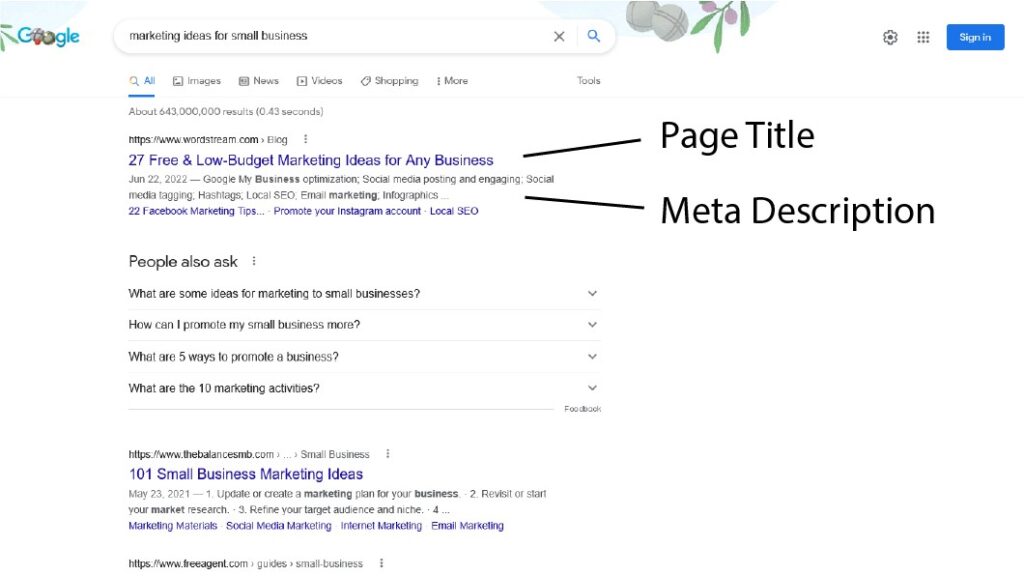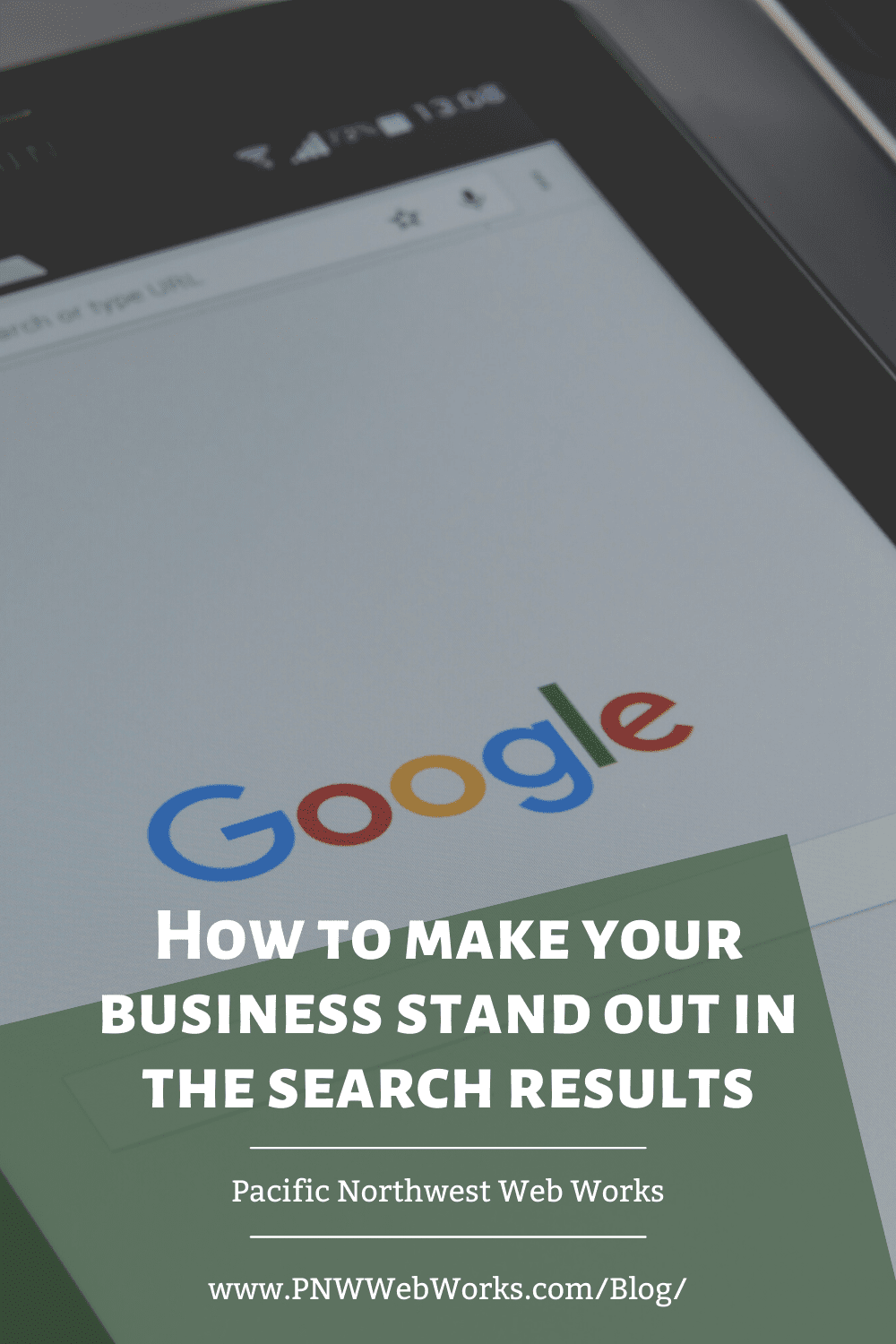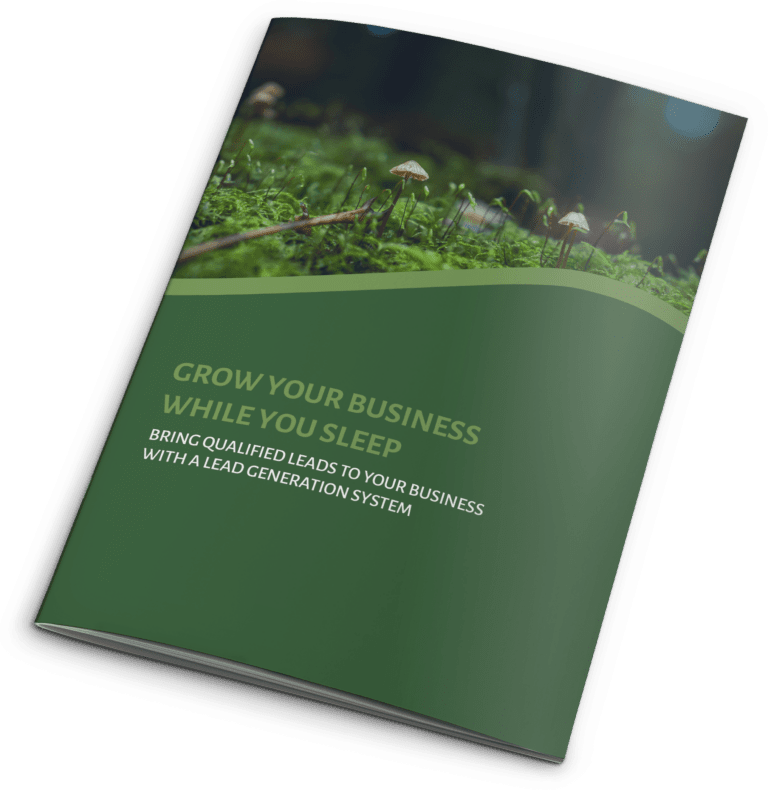Everyone wants to be on the first page when it comes to search engine results. I hear the words first page of Google so often. But even more important than the first page is having a compelling title and description.
When you use Google and are viewing the search results, before you click on a link, you no doubt will read the title of the page. And often you probably read the description that is below the title and link. These are your first clues to help you sort out if that page will have the information, you are looking for.
The title and description are the easiest way to help your page rank higher and get more clicks. A compelling (but accurate) title and meta description will help future visitors know what is on the page. And it will tell search engines the key points of the page.
I often see these sections of the website left to chance. And by chance, I mean the website owner supplied no information in those sections for Google and other search engines. When you leave these sections empty, search engines just grab random text from the page.
This might be what the page is about. But it might not. You are hanging your ability to rank on the hope that the search engine will understand your page and pick just the right text to show the potential visitors.

Not a place I would like to be.
So how can you write better titles and descriptions for your pages? Let’s look at the titles first, and then dive into the description.
Writing a good page title
A good title for your page has a few key factors that it needs to follow. There are lots of “title rules” out there. But you need to throw that word “rule” away. No one knows for sure how the search engines rank the pages. They will never tell us because then everyone would game the system.
Really what we have are a bunch of guidelines and evidence-based facts. But not every page or every scenario is the same. What works on your pages might not work on someone else’s. The key here is to play and see what works for the site.
Title Length
The first thing to remember when crafting a great title is the length. It is recommended to keep your title at 60 characters long. Yes, I know this is rather short. But remember this is a guide.
Shorter is ok too. But make the most use you can of the title tag and try to get as close as you can to the 60. You can make them longer too, but there are some problems. First search engines will still only show around the 60-character length.
What this means is that you need to keep your most important keywords towards the front of the title. Search engines will read a whole lot more. But it probably won’t help you very much.
I have seen titles on pages that are 200 characters long and the page still ranks well. But the information in the front is most important to the search engine and future visitors. They will use that information to decide if they want to visit your page.
The closer your keywords are to the front the more likely they will show up. But don’t go overboard here either. If it makes sense to have a long title, go with it. But DO NOT stuff the title with keywords. Google will know and will punish your site.
Often my blog titles will run long. And then I like to brand my pages with my business name. I throw the business name at the end, so if it gets cut off, oh well. It’s not the important part.
Keep the title relevant
We have all seen those clickbait titles. And probably clicked on more than a few of them as well. It is such a disappointment to get to the other side and the article is nothing like what the title says it is.
Spammy titles will do nothing other than hurt your site. If someone lands on the other side and they don’t find what they are looking for they click back. This click back or bounce as it’s called in the industry is tracked by the search engines.
The higher your bounce rate, the less your site will show in the search results. Google won’t keep sending people to your site if there is nothing useful to everyone it sends there. It wants to deliver the right result every single time.
Distill your article into a clean and precise title tag. Include relevant information. Don’t stuff it with extra or irrelevant data.
Think about the searcher, not the engine

Your goal should be to supply relevant data to the searcher. A search engine is just a tool.
Yes, you want the engine to understand your page. But the engine can understand from a string of words all jumbled together.
For example, this article could easily be called “Title Tag Meta Description Optimization Tip How To Search Engine”. But that is not user-friendly and makes me look like I can’t speak English. Definitely not an article I want to read.
Write your title tags for the human read at the other end. Let the search engine think what it will.
Optimize and change the title
Write your titles and see how they do. Monitor the results and see how many users find your page and what keywords they use to get there.
Change your title tag if you see it is not working or you are ranking for the wrong terms. When you rank for the wrong terms, it means the search engine did not understand and you need to help them a little.
Give it at least 3 months before making changes. It takes time to rank and for the search engines to start showing your articles.
Writing a good meta description
The meta description is that little block of text that shows in the search results under the title. It’s important to set the section to not only help search engines but the searchers.
When it comes to a meta description, every platform is different in how to set the description. In WordPress, a lot of plugins allow you to set this description. It is not built into the core of WordPress at this time.
I prefer to use a plugin called SEOPress on all my sites and client sites. It not only allows you to set the meta description, but you can also set an SEO-friendly title, and even set the social media information so if someone shares your article, it shows up right on places like Facebook.
This article won’t go into how to install or use any of these tools, but rather focus on the writing. Remember, same as with title takes, these are only guidelines. The search engines won’t tell us exactly how to do this.
If you would like help with adding or changing the meta descriptions on your site, reach out to us.
Optimal length of the page (meta) description
When it comes to the description length it is recommended to stick around 160 characters.
Again, you can go longer if needed. But when your description is longer than the results page allows, your text will be cut off by an ellipsis (…) instead of showing the whole thing. In most cases, the search engine will read the entire thing. But this is not the place to go stuffing extra words.
Just like with title, order matters. You want to keep the important bits and most relevant keywords towards the front of the description. That way if you do end up going over and it gets cut off, the most relevant information is still presented to the user.
What should the description say?
The description is just that. A short description of what the page talks about. It should have keywords that you are trying to optimize the page for. And it should be a clean written sentence or two.
You want to write for the user in everything you do. Think of it as if you were browsing for a page like yours. What would you rather read? A bunch of random words and irrelevant information, or a description that clearly says what the page is about and invites you to read it?

Think of the description as a mini advertisement and you are trying to sell the user on your page over the others. Make it compelling and interesting. Keep it on topic.
Reflection on the topic
Both the title tag and the meta description should reflect the topic of the page. I touched on this in the title section.
Nobody likes and spammy page. It is your job to keep things on topic and help the user find the best result. Even if that result is not yours. You need to ensure the content you are producing is highly relevant and the best it can be.
The title and description should be the most concise and interesting you can while keeping them on the right topic. A high bounce rate is not good, and you want to avoid collecting the wrong visitors to your site. It’s bad for you and bad for them.
Make your title and description unique
Another common mistake I see on websites is people using the same title or description on a bunch of pages. This only serves to confuse the search engine and visitor.
Take the time to write a unique title for each page that is clear and has useful words to describe the page. Pages title “Home”, “Services”, etc. are not useful to the end user. What are your services? What is on your home page?
The same goes with using your business name as the title for every single page. Great, we get it; you love your business. But what the heck do you do? Or what is this page about? Give us some details.
The same goes for the description. Don’t just copy and paste your description across the site whole site. Make each one unique and based on the topic of the page.
Conclusion
By taking the time to write better title tags and descriptions across your site, you increase the chances of ranking in the search engines. You also create the best user experience for the guests.
The whole point of having a website is to get new visitors and teach or convert those visitors into customers. When you write for your customers you make your website more effective.
I encourage you to go look at the titles and descriptions on your site and see how you can perfect them. If nothing else, ensure you have them on your site so that you are not at the mercy of the search engines picking some random text for you.








